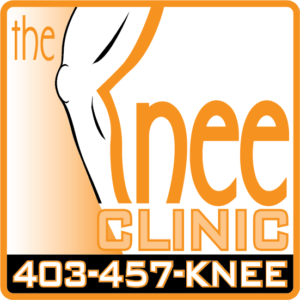Knee braces are used for a plethora of different clinical indications. Being that we are the only private knee clinic in Alberta, we are intimately knowledgeable on these different braces and their appropriateness for various clinical conditions.
Patellar Stabilization Knee Braces
Knee braces can range from off the shelf to fully custom, can range in size from really quite small to relatively onerous, light weight to cumbersome, flexible to stiff. The smallest and simplest knee brace that we offer in our clinic is a patellar stabilization brace called a Knee-O-Tracker. This small neoprene brace has a buttress on one side that can be tightened or loosened in order to create stability to either the medial or lateral side of the kneecap, depending on which way the kneecap is prone to subluxing or even dislocating. Relatively comfortable and able to be worn underneath most pants, it does a good job of decreasing the chances of recurrent subluxation or dislocation but is not strong enough to truly stop the dislocation incident, if appropriate forces are applied.
Mechanoreceptive Knee Braces
Next in the line of brace control is something called a GenuTrain by Bauerfeind. This German company creates a woven, soft knee sleeve that is elastic in certain planes of motion and non-elastic in other planes of motion. It is excellent at stimulating what are known as the mechanoreceptors, small sensors in the skin that make your brain more cognizant of the position of your knee relative to the rest of your body. While they do not create true knee control, they do wake up the muscles in the area to a statistically significant degree and give people a greater sense of confidence during activities of daily living. GenuTrain knee braces also come in a new osteoarthritic unloader version. This unloader version takes the mechano-receptive fabric brace and adds BOA adjustable straps to it in order to create mechanical unloading to the medial or lateral compartment of the knee, depending on which way you wear the brace. This brace is not custom but comes in six different sizes and so can be made to fit quite snugly. A very comfortable brace, it again helps the patient feel more confident in their day-to-day activities.
Custom Meniscal / Cartilage Unloader Knee Braces
Moving up the scale of unloading control, we get to a brace made by Ossur called a Rebound Cartilage Unloader. This unloader knee brace is custom made and is very svelte. It can be designed to either unload the medial or lateral compartment and begins to unload from a 45-degree flexion knee bend, making it unique amongst unloader braces, which typically unload from 30 degrees of flexion to full extension. Its light weight and low profile make it an excellent option for thin or lean patients who have either acute or subacute meniscal damage postoperative meniscal repair or early degenerative changes.
Custom Osteoarthritis Unloader Knee Braces
The most common brace utilized in our clinic is the custom OA Unloader One made by Ossur. This brace is the gold standard for medial or lateral compartment unloading. It is thin, light weight, and custom fit down to the millimetre. It is very comfortable and single-handedly has helped thousands of our patients either get back to or continue with activities that they are passionate about that they were not able to do without this brace. In cases of bone bruises or impaction fractures, this brace helps to alleviate symptoms remarkably well and quickly.
Custom Ligament Knee Braces
In our opinion, the best and lightest custom ligament brace on the market is the CTI made by Ossur. CTI originally stood for carbon and titanium, the materials with which this knee brace was comprised. Both materials are vaunted for their strong mechanical characteristics and exceptional light weight. Over the years, the CTI has undergone revision after revision and has become progressively better. It is now a very light weight, preimpregnanted carbon fibre that is exceptionally strong. Measured with attention to detail, it is accurate down to the millimetre, and consequently is very comfortable for the patient and exceptionally good at stopping any extraneous motions medially, laterally, anteriorly, or posteriorly of the shin relative to the femur. It also stops any excessive varus and valgus loads, but it cannot stop internal torque.
A different version of the CTI is the CTI OA. This particular custom brace has all the same features of CTI but can be built with a degree of unloading incorporated either laterally or medially depending on the particulars of the patient’s case. Where the degree of unloading is adjustable in something like a rebound cartilage or Unloader One, in a CTI OA the degree of unloading is predetermined at the time of manufacture.
Insurance Coverage
Most people’s insurance companies will have coverage for non-custom knee braces and most insurance companies have a separate, distinct provision for coverage of custom knee braces. Following a comprehensive history, physical examination and review of any appropriate imaging at our Knee Clinic, we are able when clinically indicated to write you a prescription that you can submit to your insurance in order to be reimbursed, often for 100% of the cost of the knee brace. Some of these knee braces carry a one-year fit warranty so that if the patient’s changes, the laboratory will remake the brace from scratch for free. Both Bauerfeind and Ossur have excellent reputations for standing behind their work and although they very rarely have manufacturing issues, if ever there is something that arises, they stand behind their products remarkably well, as do we.
Should you have any questions about your own knee or if you would like to bring in your current knee brace to see if it still fits, or needs adjusting, or perhaps needs to be replaced, please phone us at (403) 457-5633.

